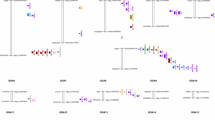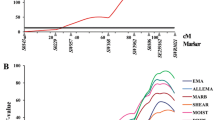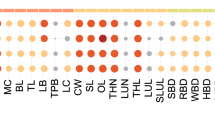Abstract
In recent decades, selection in pig farming has been aimed at obtaining animals with a high growth rate and increased meat yield in the carcass, resulting in a tendency for deteriorated quality characteristics of pork. One way to solve this problem is to develop genetic markers of pig meat quality and to use them in breeding programs along with the markers of other productive traits. The article presents the results of the analysis of the association of genes IGF2 (SNP g.3072G > A), CTSD (SNP g.70G > A), and CTSF (SNP g.22G > C) localized in the QTL region of the distal end of the p-arm of chromosome 2, with the meat quality traits and carcass structure in pigs of the Ukrainian Large White breed (ULW). According to these SNPs, all genes were characterized by a high level of polymorphism (PIC = 0.343–0.371). The association of CTSD (SNP g.70G > A) with the content of intramuscular fat (p = 0.02), moisture content in meat (p = 0.03), and its moisture-holding capacity (p = 0.03) was established. CTSD (SNP g.70G > A) also had an additive effect on an important selection trait: the backfat thickness (p = 0.05); it was the highest in pigs of the g.70GG genotype. Associations of CTSF (SNP g.22G > C) with the moisture content in meat (p = 0.01) and IGF2 (SNP g.3072G > A) with the moisture loss from meat during heat treatment (p = 0.01) were revealed. The polymorphisms of the studied genes can be used as genetic markers in marker-associated selection of the Ukrainian Large White pig breed.
Similar content being viewed by others
REFERENCES
Balatsky, V., Oliinychenko, Y., Sarantseva, N., et al., Association of single nucleotide polymorphisms in leptin (LEP) and leptin receptor (LEPR) genes with backfat thickness and daily weight gain in Ukrainian Large White pigs, Livestock Sci., 2018, vol. 217, pp. 157–161. https://doi.org/10.1016/j.livsci.2018.09.015
Balatsky, V.M., Vovk, V.O., Buslyk, T.V., et al., The genetic-associated analysis of g. 22 G > C single-nucleotide polymorphism in F cathepsin gene of different pig breeds, Bull. Poltava State Agrar. Acad., 2018, vol. 4, pp. 137–141. https://doi.org/10.31210/visnyk2018. 04.20
Balatsky, V.N., Saienko, A.M., Pena, R.N., et al., Genetic diversity of pig breeds on ten production quantitative traits loci, Cytol. Genet., 2015, vol. 49, no. 5, pp. 299–307. https://doi.org/10.3103/S0095452715050023
Boccard, R., Buchter, L., Casteels, M., et al., Procedures for measuring meat quality characteristics in beef production experiments, Report of a Working Group in the Commission of the European Communities (CEC) Beef Production Research Programme, Li-vest Prod. Sci., 1981, vol. 8, pp. 385–397. https://doi.org/10.1016/0301-6226 (81)90061-0
Bohrer, B.M., Clark, D.L, Tavárez, M.A., et al., Effect of an insulin-like growth factor 2 single nucleotide polymorphism on fresh belly characteristics and bacon slicing yields of finishing pigs, Meat Sci., 2015, vol. 101, pp. 109–110. https://doi.org/10.1016/j.meatsci.2014.09.029
Burgos, S.C., Llambн, D.S., Hidalgo, G.J., et al., Selection markers in Pampa Rocha pigs: a comparison with autochthonous breeds of Spain and Portugal, J. MVZ Cordoba, 2019, vol. 24, no. 2, pp. 7198–7202. https://doi.org/10.21897/rmvz.1642
Clark, D.L., Bohrer, B.M., Tavárez, M.A., et al., Effects of the porcine igf2 intron 3-g3072a mutation on carcass cutability, meat quality, and bacon processing, J. Anim. Sci., 2014, vol. 92, no. 12, pp. 5778–5788. https://doi.org/10.2527/jas.2014-8283
Cobanovic, N., Stajkovic, S., Grkovic, N., et al., Effects of RYR1 gene mutation on the health, welfare, carcass and meat quality in slaughter pigs, IOP Conf. Ser.: Earth Environ. Sci., 2019, vol. 333. https://doi.org/10.1088/1755-1315/333/1/012051
Criado-Mesas, L., Ballester, M., Crespo-Piazuelo, D., et al., Analysis of porcine IGF2 gene expression in adipose tissue and its effect on fatty acid composition, PLoS One, 2019, vol. 14, no. 8, pp. e0220708. https://doi.org/10.1371/journal.pone0220708
Danley, R.L., New heat flux DSC measurement technique, Thermochim. Acta, 2002, vol. 395, nos. 1–2, pp. 201–208. https://doi.org/10.1016/S0040-6031(02)00212-5
Davoli, R., Schivazappa, C., Zambonelli, P., et al., Association study between single nucleotide polymorphisms in porcine genes and pork quality traits for fresh consumption and processing into Italian dry-cured ham, Meat Sci., 2016, vol. 126, pp. 73–81. https://doi.org/10.1016/j.meatsci.2016.11.01
Fontanesi, L., Speroni, C., Buttazzoni, L., et al., The insulin-like growth factor 2 (IGF2) gene intron3-g.3072G>A polymorphism is not the only Sus scrofa chromosome 2p mutation affecting meat production and carcass traits in pigs: evidence from the effects of a cathepsin D (CTSD) gene polymorphism, J. Anim. Sci., 2010, vol. 88, pp. 2235–2245. https://doi.org/10.2527/jas.2009-2560
Fontanesi, L., Scotti, E., Speroni, C., et al., A selective genotyping approach identifies single nucleotide polymorphisms in porcine chromosome 2 genes associated with production and carcass traits in Italian heavy pigs, Ital. J. Anim. Sci., 2011, vol. 10, no. 2, pp. 72–77. https://doi.org/10.4081/ijas.2011.e15
Fontanesi, L., Speroni, C., Buttazzoni, L., et al., Association between polymorphisms in cathepsin and cystatin genes with meat production and carcass traits in Italian Duroc pigs: confirmation of the effects of a cathepsin L (CTSL) gene marker, Mol. Biol. Rep., 2012, vol. 39, no. 1, pp. 109–115. https://doi.org/10.1007/s11033-011-0715-4
Grau, R. and Hamm, R., Über das Wasserbin-dungsvermgen des Sugetiermuskels. II. Mitteilung. Über die Bestimmung der Wasserbindung des Muskels, Zeitschrift Lebensmittel-Intersuchung Forschung, 1957, vol. 105, no. 6, pp. 446–460. https://doi.org/10.1007/BF011-26901
Hao, L.L., Yu, H., Zhang, Y., et al., Single nucleotide polymorphism analysis of exons 3 and 4 of IGF-1 gene in pigs, Genet. Mol. Res., 2011, vol. 10, pp. 1689–1695. https://doi.org/10.4238/vol10-3gmr1328
Official Methods of Analysis of the AOAC, 13th ed., Horwitz, W., Ed., The Association of Official Analytical Chemists, 1111 N. 19th St., Arlington, VA 22209, 1980. https://doi.org/10.1002/jps.2600700437
Hu, Zhi-L., Park, C.A., and Reecy, J.M., Building a livestock genetic and genomic information knowledge base through integrative developments of Animal QTLdb and CorrDB, Nucleic Acids Res., 2019, vol. 47 (D1), pp. D701–D710. https://doi.org/10.1093/nar/gky1084
Karpushkina, T.V., Kostyunina, O.V., Sizareva, E.I., et al., Productive traits of large white pigs depending on IGF2 and CTSD genotypes, Dostizh. Nauki Tekhn. APK, 2016, vol. 30, no. 6, pp. 82.
Kenchaiwong, W., Duangjinda, M., and Boonkum, W., Polymorphisms of candidate genes associated with feed efficiency and growth traits in commercial crossbred pigs, J. Sci. Technol., 2019, vol. 41, no. 5, pp. 1069–1075.
Kostyunina, O.V., Kramarenko, S.S., Svezhentseva, N.A., et al., The association of IGF2 with productive traits of pigs of large white breed in the aspect of sexual differentiation, Agric. Biol., 2015, vol. 50, no. 6, pp. 736–745. https://doi.org/10.15389/agrobiology.2015.6.736rus
Martínez-Montes, M., Fernández, A., Mucoz, M., et al., Using genome wide association studies to identify common QTL regions in three different genetic backgrounds based on Iberian pig breed, PLoS One, 2018, 2018, vol. 13, no. 3. e0190184. https://doi.org/10.1371/journal.pone.0190184
Nezer, C., Moreau, L., Brouwers, B., et al., An imprinted QTL with major effect on muscle mass and fat deposition maps to the IGF2 locus in pigs, Nat. Genet., 1999, vol. 21, pp. 155–156. https://doi.org/10.1038/593
Oczkowicz, M., Tyra, M., Walinowicz, K., et al., Known mutation (A3072G) in intron 3 of the IGF2 gene is associated with growth and carcass composition in Polish pig breeds, J. Appl. Genet., 2009, vol. 50, no. 3, pp. 257–259. https://doi.org/10.1007/BF03195681
Peakall, R. and Smouse, P.E., GenAlEx 6.5: genetic analysis in Excel, population genetic software for teaching and research—an update, Bioinformatics, 2012, vol. 28, no. 19, pp. 2537–2539. https://doi.org/10.1093/bioinformatics/bts460
Pena, R.N., Ros-Freixedes, R., Tor, M., et al., Genetic marker discovery in complex traits: a field example on fat content and composition in pigs, Int. J. Mol. Sci., 2016, vol. 17, no. 12, p. 2100. https://doi.org/10.3390/ijms17122100
Piyrkowska, K.L., Ropka-Molik, K., Eckert, R., et al., The association between polymorphisms of three cathepsins and economically important traits in pigs raised in Poland, Livestock Sci., 2012, vol. 150, pp. 316–323. https://doi.org/10.1016/j.livsci.2012.09.022
Qiao, R., Gao, J., Zhang, Zh., et al., Genome-wide association analyses reveal significant loci and strong candidate genes for growth and fatness traits in two pig populations, Genet. Select. Evol., 2015, vol. 47, p. 17. https://doi.org/10.1186/s12711-015-0089-5
Ramos, A.M., Glenn, K.L., Serenius, T.V., et al., Genetic markers for the production of US country hams, J. Anim. Breed. Genet., 2008, vol. 128, pp. 248–257.https://doi.org/10.1111/j.1439-0388.2007.00710.x
Russo, V., Davoli, R., Nanni Costa, L., et al., Association of the CTSB, CTSF and CSTB genes with growth, carcass and meat quality traits in heavy pigs, Ital. J. Anim. Sci., 2003, vol. 2, no. 1, pp. 67–69. https://doi.org/10.4081/ijas.2003.11675917
Russo, V., Fontanesi, L., Davoli, R., et al., Linkage mapping of the porcine cathepsin F (CTSF) gene close to the QTL regions for meat and fat deposition traits on pig chromosome 2, Anim. Genet., 2004, vol. 35, pp. 155–157. https://doi.org/10.1111/j.1365-2052.2004.01105.x
Russo, V., Fontanesi, L., Scotti, E., et al., Single nucleotide polymorphisms in several porcine cathepsin genes are associated with growth, carcass, and production traits in Italian Large White pigs, J. Anim. Sci., 2008, vol. 86, pp. 3300–3314. https://doi.org/10.2527/jas.2008-0920
Simonetti, A., Rando, A., Di Gregorio, P., et al., Variability of the IGF2 locus in the Suino Nero Lucano pig population and its effects on meat quality, Anim. Prod. Sci., 2017, vol. 58, no. 11, pp. 1976–1982. https://doi.org/10.1071/AN17051
Tocci, A.M. and Mascheroni, R.H., Characteristics of differential scanning calorimetry determination of thermophysical properties of meats, Lebensmittel-Wissenschaft und-Technologie, 1998, vol. 31, no. 5, pp. 418–426. https://doi.org/10.1006/fstl.1998.0319
Untergasser, A., Nijveen, H., Rao, X., et al., Pri-mer3Plus, an enhanced web interface to Primer3, Nucleic Acids Res., 2007, vol. 35, no. 2, pp. W71–W74. https://doi.org/10.1093/nar/gkm306
Van Laere, A.S., Nguyen, M., Braunschweig, M., et al., A regulatory mutation in IGF2 causes a major QTL effect on muscle growth in the pig, Nature, 2003, vol. 425, no. 6960, pp. 832–836. https://doi.org/10.1038/nature02064
Zhang, C., Bruce, H., Yang, T., et al., Genome Wide Association Studies (GWAS) identify QTL on SSC2 and SSC17 affecting loin peak shear force in crossbred commercial pigs, PLoS One, 2016, vol. 11, no. 2. e0145082. https://doi.org/10.1371/journal.pone.0145082
Funding
This study was supported by the National Academy of Agrarian Sciences of Ukraine at the expense of the budget program “Innovative Technologies of Breeding, Industrial, and Organic Production of Pig Products.” Subprogram the “Development of Modern Systems of Selection and Hybridization Using Molecular Genetic Methods,” state registration no. 0116U005008.
Author information
Authors and Affiliations
Corresponding author
Ethics declarations
Conflict of interests. The authors declare that they have no conflict of interest.
Statement on the welfare of animals. All applicable international, national, and/or institutional guidelines for the care and use of animals were followed.
Additional information
Translated by V. Mittova
About this article
Cite this article
Balatsky, V.N., Oliinychenko, Y.K., Buslyk, T.V. et al. Associations of QTL Region Genes of Chromosome 2 with Meat Quality Traits and Productivity of the Ukrainian Large White Pig Breed. Cytol. Genet. 55, 53–62 (2021). https://doi.org/10.3103/S0095452721010023
Received:
Revised:
Accepted:
Published:
Issue Date:
DOI: https://doi.org/10.3103/S0095452721010023




